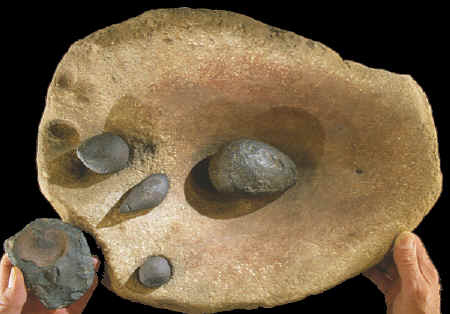|
ABSTRACT:

PLUMMET GRINDING
STONE
WOODLAND PERIOD
ST. CHARLES COUNTY, MISSOURI
This article describes and illustrates a large grinding stone that
was used to grind, shape and process hematite iron ore. It was found in 2001 in St. Charles County, Missouri. Intact sandstone grinding
stones of this size are fairly rare in the Mississippi Valley region. This
example is heavily stained with red ochre and was obviously involved with
processing hematite. One finished plummet, one plummet "blank" and a
small piece of hematite was found nearby indicating this was a site where
plummets and red ochre pigment were probably being made. The pigment may have been a byproduct of plummet making or, the
other way around, plummets may have been a byproduct from the production of
red ochre pigment. Both plummets and pigment were probably being made with
this grinding stone. |
|
|
"The inorganic colors used by the Indians were mostly derived
from iron-bearing minerals, such as ochers and other ores, and
stained earths".---1912,
Fredrick W. Hodge, Handbook of American Indians North of Mexico.
"In shaping their numerous implements,
utensils and ornaments of stone, wood, bone, shell, and metal, the
native tribes were largely dependent on abrading implements,
of which there were many varieties".---1912,
Fredrick W. Hodge, Handbook of American Indians North of Mexico.

A
PLUMMET
& RED OCHRE
GRINDING STONE FROM MISSOURI
Stone Age peoples used a wide variety of abrasive stone tools to shape,
grind, crush, pulverize and abrade everything from food stuffs to
pigments. In the region of the Mississippi Valley they were also
used to make utilitarian objects like axes, celts and adzes and
non-utilitarian "ceremonial" objects like polished
lizards, spuds or cones. Many of these tools were made
of sandstone, a material known for its ability to cut and wear away
the surfaces of many different kinds of materials. The most common of
these tools are small pieces of sandstone that were used as
abraders to sharpen and shape items made of antler, bone, shell and
wood. Another common tool used for grinding and pulverizing food
products like grains, seeds and nuts are the mortars and metates
that have been found in large numbers on sites in the southwestern
United States.
|
|

CLICK ON PICTURE FOR LARGE IMAGE
LARGE GRINDING STONE & HEMATITE
ARTIFACTS
ST. CHARLES CO.,
MISSOURI AND ILLINOIS
PRIVATE
COLLECTION
This large sandstone grinding stone that was
found on a construction site in St. Charles County, Missouri
in 2002. Two of the three smaller hematite artifacts were
found in direct contact with the grinding stone. The Snyders
Grooved
plummet was found about 50 feet away and may also be directly
related. The largest piece of hematite shows various reduction
processes such as scraping, hammering and grinding. The other
artifact, laying in the center of the grinding cavity, is a
plummet "blank" that was evidently being pecked,
ground and shaped to form a plummet.
Notice the heavy red stain on the surface of the
grinding cavity. This material is red ochre and was caused from grinding hematite. |
|